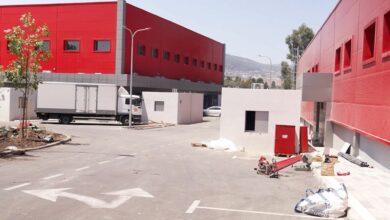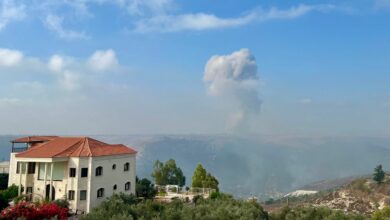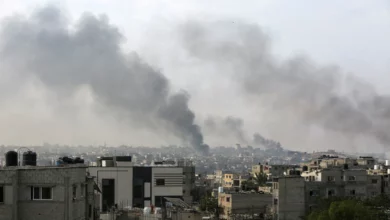Through the blurry self-portraits and dark images fused with symbolism they silently share the torment, anger and fear they have lived through.
One photo shows a decaying shower. This is where he used to make her wash off the blood after he beat her. Sometimes, he’d even take the time to hear her and the children what they would prefer to be beaten with. “He surprised us by asking our opinion on which tool of torture he should use; you can pick the hose, the stick, the axe….etc. After this, he would make his own decision,” wrote the woman, who only identifies herself as S.K.
Another picture further down in the room shows the wretched face of a woman, her hand clutched to her mouth. “This is my story. I am Almaza…I married Moussa with whom I have two children, Hani and Mariana. He practiced all kinds of tricks on us–defamation, scolding, and treachery and robed everything we had. Even our dignity,” she writes in a note accompanying the image, signed H.A.
Their photos along with the works of eight other women are currently on display at the Lebanese Ministry of Tourism in Beirut in the exhibition “Behind the Doors: Through the Eyes of Women Survivors of Violence,” which is scheduled to tour around Lebanon.
The exhibition is the result of a three-month workshop financed by the Italian government and opened concurrently with the kick-off of “16 Days of Activism against Gender Violence,” a two-week long event where activists around the world call for an end to gender-based violence and domestic abuse.
Photographer Dalia Khamissy teamed up with KAFA, a Lebanese rights group working to eradicate gender-based violence and child abuse. Through KAFA, Khamissy was introduced to the ten women who participated in the workshop. They are among scores of survivors of domestic violence who receive support from KAFA.
The women were given simple digital cameras and received training in photography by Khamissy. “I wanted to empower the ladies and let them tell their stories and the violence they experienced,” Khamissy says. “I’m so proud of their work.” Khamissy adds that many of the participants had little or no experience in photography before joining the workshop.
Yet many of their images on display look more like the work of a professional than amateur photographers. A few meters from where Khamissy stands, there is a series of striking, blurred images of a woman sitting in various positions in her house. Her face is hidden from the camera lens. Below the images, the photographer has posted her personal reflections headlined, “I am still waiting.”
“Five years ago he kidnapped my three daughters on Mother’s Day. For the past five years I spent my days searching for them. For the past five years I waited hopelessly for their return,” writes the woman who identities herself as H.D.
Another woman told her story through a series of shots of her own body, while others explored the themes through symbolism. One collection of photos shows a white wedding dress hanging from a bare tree in what looks like a wasteland.
In another picture, a pair of white underwear has been placed on a brick wall. “I am in my fifties and this image keeps haunting me,” reads the caption, written by B.H.
Khamissy likes to refer to the project as a type of “art therapy.” She recalls how many emotions were stirred during the workshop as the women revisited their dark pasts and the places they forever will link to abuse and fear.
On a number of occasions, says Khamissy, the group broke out in tears and cried together during the photography sessions.
The gripping images appear to also have stirred the emotions of those visiting the exhibition. Khamissy says many were “shocked” when they saw the images. “Lots of people were shocked that these things happen in Lebanon,” she adds.
Khamissy hopes the project will help raise public awareness about domestic abuse and break the taboo on the topic. “People just don’t even know that this exist,” she says. “Lots of women don’t think they should be talking about it. Some even think men have the right to do it.”
KAFA director Zoya Rouhana describes the exhibition as “a visual framework of the pain that a few women went through over many years, and of a suffering that remained absent from the social awareness and buried in the maze of the privacy of the families and the social taboos.”
Drawing on the diverse backgrounds of the participants in the workshop, Khamissy suggests that domestic abuse is an issue that affects all levels of society.
“These women come from different social and religious backgrounds. There are Muslims and Christians, rich and poor,” she says.
Accurate statistics on domestic violence in Lebanon are hard to come by. The topic still has much stigma associated with it. But some reports claim that at least three quarters of Lebanese women have experienced domestic abuse at some point in their lives.
There is no clause in the Lebanese penal code that protects women from domestic abuse. Those who try to escape the abuse risk facing myriad legal problems and social stigma.
It is Khamissy’s hope that the photo exhibition will illustrate the need for new legislation on domestic violence.
KAFA has a draft law in the pipeline which would pave the way for opening of special police stations and courts to handle cases relating to family violence. Abusers would be penalized financially and would have to pay both medical and legal fees.
Rouhana hails the participants for having the courage to stand up and break the silence on the stigmatized topic. “This is a salute to the women who decided to revolt against what others consider an inevitable fate and unchangeable reality, despite the fact that their resistance is still unrecognized, unprotected, and unsupported,” she says.




